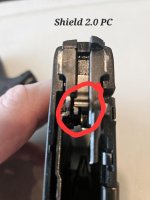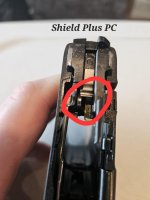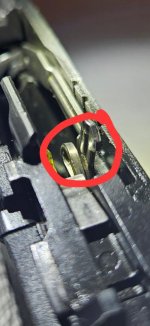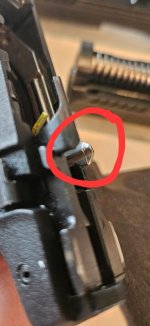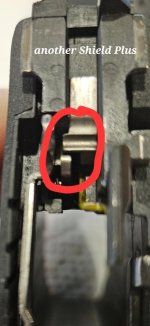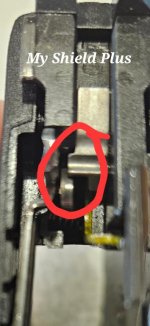CouchPotato
Well-known member
- Joined
- Feb 25, 2022
- Messages
- 190
- Reaction score
- 282
I've carried a M&P Shield 2.0 PC 3.1" for about 3 years and I recently upgraded to the M&P Shield Plus PC 3.1" for the purposes of increased capacity, slightly larger grip circumference, and an improved trigger. I've put 500 rounds through it without any problems.
The only issue I noticed was that during takedown, sometimes the trigger could not be pulled in order to release the slide, and the yellow sear deactivation lever had to be manually moved down. Not a big deal. I thought maybe it was a break-in related issue.
Last night I cleaned it and reassembly was a challenge because the trigger wouldn't engage the sear... there was just some crunching and a popping sound. Another disassembly and reassembly fixed the problem but during dry fire afterwards, the issue returned. At first it worked but after about a dozen trigger pulls the problem started again and the trigger would not engage and would not release the striker, there was only some crunching and a popping sound.
So then I disassembled the gun again and flooded all components in the grip with pressurized Rem Oil and set it upside down to drain. While cleaning up the Rem Oil with a Q-tip I noticed a tiny metal shaving laying in between the front of the sear housing and the back of the trigger bar. It was loose and the Q-tip picked it up. I wish I had taken a picture.
After cleaning up all the excess Rem Oil, and reassembling the Shield Plus, I can not recreate the issue during dry fire, it works every time. I've taken it down and put it back together a dozen times and it works 100% during dry fire.
I can however recreate the issue during take down if I don't use the sear deactivation lever and try to release the slide with a trigger pull. Unless I pull the slide back a little to align with the back of the frame, the trigger will not engage the sear and there's only a popping sound.
With my Shield 2.0 PC, during disassembly, when I drop the slide, it automatically returns to home and I can just pull the trigger to release the side. I don't have to line up the slide at all in order for the trigger to work.
To further test, I put my Shield Plus slide on my Shield 2.0 frame, and the Plus slide also went to home and allowed a disassembly with a quick trigger pull. I then put my 2.0 slide on my Plus frame and again during disassembly I had to fidget with the slide position in order to allow the trigger to engage.
If it wasn't for the ongoing takedown anomaly, I would have dismissed the shaving of metal laying near the sear as a break-in issue, because obviously that shaving of metal interfered with the sear and trigger bar in some way.
Because i can recreate the issue during takedown, and the inconsistency between the Plus and 2.0 frame during takedown, I'm concerned this may be the first or second sign of a larger issue developing in my Shield Plus.
What are your thoughts? Is it good to go? With this being a carry gun, this issue does undermine my confidence level.
I was planning on going shooting with the Plus tomorrow but now I'm not sure if i should. Customer service for S&W is closed for the weekend and with tomorrow being a holiday, I don't know if they'll be open then either.
On your Shield Plus, during takedown do you have to manually position the slide in order for the trigger to engage and release the slide?
I'm trying to determine if this is an issue or a non-issue.
I guess my next step will be a couple hundred dry fires on snap caps in order to see what happens.
Thanks for the help.
The only issue I noticed was that during takedown, sometimes the trigger could not be pulled in order to release the slide, and the yellow sear deactivation lever had to be manually moved down. Not a big deal. I thought maybe it was a break-in related issue.
Last night I cleaned it and reassembly was a challenge because the trigger wouldn't engage the sear... there was just some crunching and a popping sound. Another disassembly and reassembly fixed the problem but during dry fire afterwards, the issue returned. At first it worked but after about a dozen trigger pulls the problem started again and the trigger would not engage and would not release the striker, there was only some crunching and a popping sound.
So then I disassembled the gun again and flooded all components in the grip with pressurized Rem Oil and set it upside down to drain. While cleaning up the Rem Oil with a Q-tip I noticed a tiny metal shaving laying in between the front of the sear housing and the back of the trigger bar. It was loose and the Q-tip picked it up. I wish I had taken a picture.
After cleaning up all the excess Rem Oil, and reassembling the Shield Plus, I can not recreate the issue during dry fire, it works every time. I've taken it down and put it back together a dozen times and it works 100% during dry fire.
I can however recreate the issue during take down if I don't use the sear deactivation lever and try to release the slide with a trigger pull. Unless I pull the slide back a little to align with the back of the frame, the trigger will not engage the sear and there's only a popping sound.
With my Shield 2.0 PC, during disassembly, when I drop the slide, it automatically returns to home and I can just pull the trigger to release the side. I don't have to line up the slide at all in order for the trigger to work.
To further test, I put my Shield Plus slide on my Shield 2.0 frame, and the Plus slide also went to home and allowed a disassembly with a quick trigger pull. I then put my 2.0 slide on my Plus frame and again during disassembly I had to fidget with the slide position in order to allow the trigger to engage.
If it wasn't for the ongoing takedown anomaly, I would have dismissed the shaving of metal laying near the sear as a break-in issue, because obviously that shaving of metal interfered with the sear and trigger bar in some way.
Because i can recreate the issue during takedown, and the inconsistency between the Plus and 2.0 frame during takedown, I'm concerned this may be the first or second sign of a larger issue developing in my Shield Plus.
What are your thoughts? Is it good to go? With this being a carry gun, this issue does undermine my confidence level.
I was planning on going shooting with the Plus tomorrow but now I'm not sure if i should. Customer service for S&W is closed for the weekend and with tomorrow being a holiday, I don't know if they'll be open then either.
On your Shield Plus, during takedown do you have to manually position the slide in order for the trigger to engage and release the slide?
I'm trying to determine if this is an issue or a non-issue.
I guess my next step will be a couple hundred dry fires on snap caps in order to see what happens.
Thanks for the help.
Last edited:

